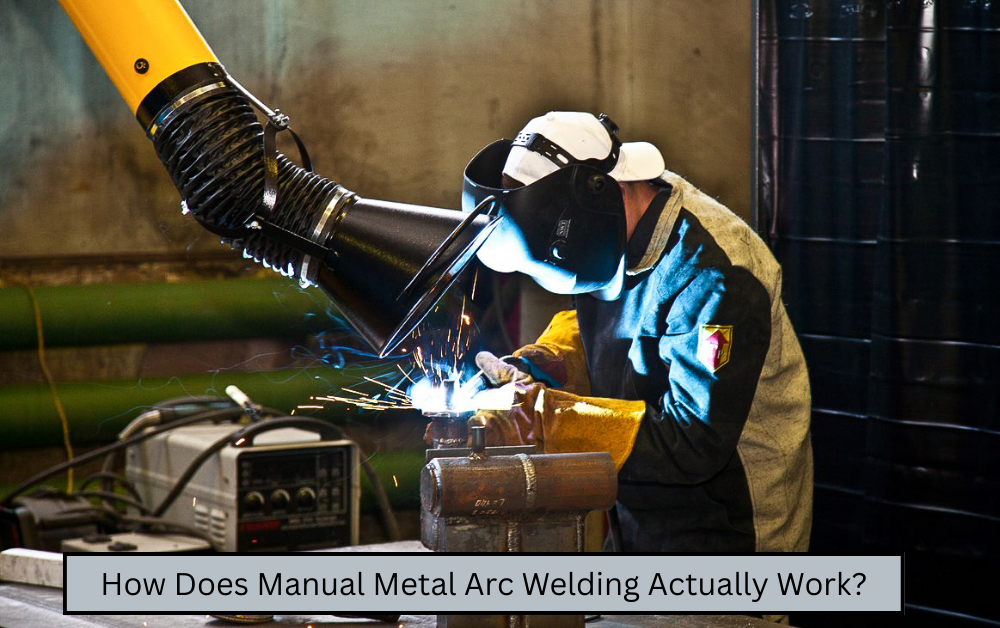
Manual Metal Arc Welding (MMAW), also known as Shielded Metal Arc Welding (SMAW) or stick welding, is one of the most commonly used welding processes in the world. It is known for its simplicity, portability, and ability to be used in various environments and on different types of metals. From construction sites to shipbuilding yards, MMA welding is a technique that continues to serve as a backbone in both industrial and domestic fabrication. But how does manual metal arc welding actually work? This article will break down the process, its components, and its practical applications.
Introduction to Manual Metal Arc Welding
Manual Metal Arc Welding is a process that uses a consumable electrode coated in flux to join metals together. When the electrode comes into contact with the metal surface, it creates an electric arc that melts both the base metal and the electrode. The melted electrode fills the joint to form a strong weld. The flux coating on the electrode plays a crucial role in protecting the weld pool from atmospheric contamination by creating a shielding gas and a layer of slag.
This welding process is favored for its versatility, affordability, and ability to be used in outdoor environments without the need for external shielding gases.
Note:- Across several industries, manual metal arc welding had been relied on for building strong joints in heavy-duty applications. It had proven effective in producing long-lasting results. Choose Rysun Techno Industries LLC for your welding requirements and experience trusted solutions from experienced professionals.
The Core Components of MMA Welding
To understand how MMA welding works, it is essential to understand the key components involved in the process:
Power Source
The power source provides the necessary electrical energy to generate the arc between the electrode and the workpiece. MMA welding uses either alternating current (AC) or direct current (DC), depending on the type of electrode and the desired characteristics of the weld. A transformer, rectifier, or inverter is commonly used to convert the input power into usable output for the welding process.
Electrode Holder
The electrode holder, also known as the stinger, is a clamp-like tool that holds the electrode in place. It allows the welder to guide the electrode with precision and safety. The electrode holder is connected to the power source through a welding cable.
Ground Clamp
The ground clamp connects the workpiece to the welding circuit. It completes the electrical circuit by allowing current to flow from the electrode, through the metal being welded, and back to the power source.
Electrodes
Electrodes used in MMA welding are metal rods coated with flux. The type of electrode determines the mechanical properties of the weld, including its strength, ductility, and corrosion resistance. Different types of electrodes are selected depending on the base metal and the welding position.

The Welding Process Explained
The actual welding process involves several steps, each of which plays a critical role in producing a sound weld.
Striking the Arc
The process begins when the welder strikes the electrode against the base metal, similar to striking a match. This action momentarily completes the electrical circuit, creating an electric arc between the electrode and the metal surface. The arc generates intense heat—up to 3,600°C (6,500°F)—which is sufficient to melt both the electrode tip and the surface of the base metal.
Formation of the Weld Pool
As the arc continues, it melts a small portion of the base metal along with the tip of the electrode. This molten material forms a weld pool. The molten electrode serves as the filler material that will bond the two metal pieces together.
Role of the Flux Coating
The flux coating on the electrode performs several critical functions during welding. First, it decomposes under heat to release shielding gases such as carbon dioxide or water vapor. These gases protect the molten weld pool from atmospheric oxygen and nitrogen, which can cause weld defects like porosity and brittleness.
Second, the flux forms a layer of slag on top of the weld pool. This slag solidifies over the weld bead and further protects it as it cools. Once the weld has cooled, the slag must be chipped away manually to reveal the finished weld underneath.
Moving the Electrode
The welder must move the electrode steadily along the joint to ensure a uniform weld. The speed, angle, and arc length all affect the quality of the weld. A short arc length produces a concentrated arc and minimizes spatter, while a long arc may cause an unstable weld and excessive slag inclusion.
Factors Affecting the Quality of the Weld
Several factors influence the outcome of the weld, and understanding them is essential for achieving consistent results:
Type of Electrode
Different electrodes are designed for different metals and applications. Common electrodes include E6010, E6011, E6013, and E7018, each offering unique characteristics in terms of penetration, arc stability, and deposition rate.
Welding Position
MMA welding can be performed in various positions—flat, horizontal, vertical, and overhead. Each position requires different techniques and often different types of electrodes for best results.
Amperage Settings
The current setting on the welding machine affects the penetration depth and arc characteristics. Too low a current may result in poor fusion, while too high a current can burn through the material and cause excessive spatter.
Operator Skill
Manual Metal Arc Welding demands a high level of skill and experience. The welder must maintain consistent travel speed, arc length, and angle to produce a clean and strong weld. Inconsistent technique can lead to defects like undercutting, porosity, and slag inclusion.
Advantages of Manual Metal Arc Welding
Despite the advent of modern automated welding technologies, MMA welding remains highly valued for a number of reasons:
- Portability: Requires minimal equipment, making it suitable for remote or outdoor work.
- Versatility: Can weld a variety of metals including steel, stainless steel, and cast iron.
- Simplicity: Easy to set up and operate with basic training.
- Cost-effectiveness: Affordable equipment and consumables.
Common Applications of MMA Welding
Due to its adaptability and ease of use, MMA welding is used in a wide range of industries and scenarios:
- Construction: For structural steel welding and onsite fabrication.
- Shipbuilding: Used for hull repairs and internal structures.
- Maintenance and Repair: Ideal for repairing machinery and equipment in the field.
- Pipeline Welding: Particularly in areas with limited access or difficult conditions.
- Agricultural Equipment: Used for building and repairing farm tools and vehicles.
Limitations and Challenges
While MMA welding offers many benefits, it also comes with certain limitations:
- Slower than automated processes: Requires more time and labor for large-scale projects.
- Need for slag removal: Slag must be cleaned after each pass, which adds to processing time.
- Higher skill requirement: Achieving high-quality welds depends heavily on the welder’s expertise.
- Limited on thin materials: Not suitable for welding thin sheets due to the risk of burn-through.
Safety Considerations
Like all welding processes, MMA welding involves risks and demands strict safety practices:
- Personal Protective Equipment (PPE): Welders must wear helmets with proper shading, gloves, fire-resistant clothing, and safety boots.
- Ventilation: Adequate ventilation is needed to avoid inhaling harmful fumes from the electrode coating.
- Fire Hazard: Sparks and hot slag can cause fires, so the welding area should be clear of flammable materials.
- Electric Shock: Proper grounding and insulated tools are essential to minimize the risk of shock.
Future of MMA Welding
Even with the growth of more sophisticated welding techniques like MIG and TIG, MMA welding continues to hold a significant place in the industry. Advances in electrode technology, power sources, and training tools (such as VR welding simulators) are helping to make MMA welding more efficient and accessible.
Furthermore, developing nations and regions with infrastructure challenges continue to rely heavily on MMA welding due to its affordability and practicality. As a result, its relevance is unlikely to fade any time soon.
Conclusion
Manual Metal Arc Welding is a tried-and-tested method that has stood the test of time. Its ability to perform under various conditions and weld different types of metals makes it an indispensable tool for countless industries. While it may not offer the speed or precision of newer techniques, its simplicity, flexibility, and effectiveness make it a go-to solution for many welding professionals. By understanding how MMA welding actually works, from arc initiation to final slag removal, welders can harness its full potential and produce strong, reliable joints with confidence.
For More insightful Articles Related To This Topic, Feel Free To Visit: Blogpulseguru



